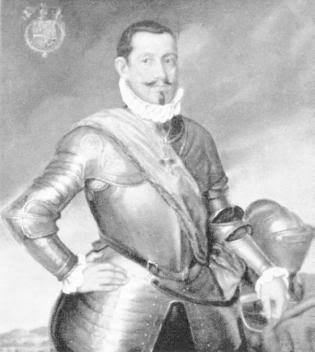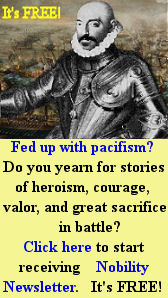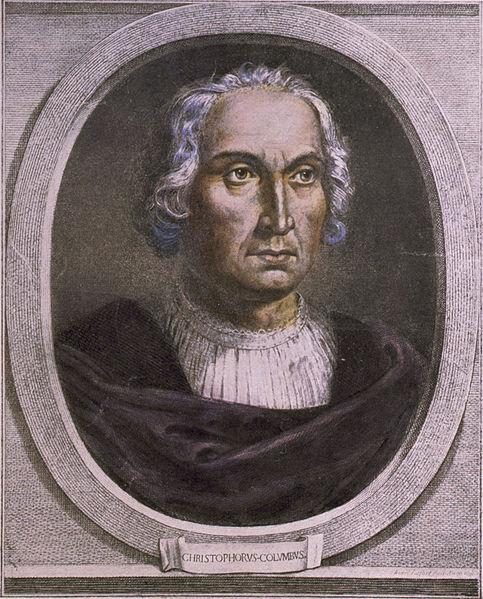
When Christopher Columbus arrived in Hispaniola, August 1498, he found open rebellion and treachery. While Columbus, on his part, was struggling with unwearied energy to repress the calamities that were destroying the colony, and by enormous sacrifice and humiliation, in fear and anxiety, succeeding in restoring some order in Hispaniola, and preparing better days to come; his enemies in Spain made use of these calamities, and by this means finally succeeded in the war they had carried on for so many years against him.
When word reached King Ferdinand and Queen Isabella of the chaos in Hispaniola, they decided to send an emissary to investigate. Unknowing to their Majesties, the one they sent was a greedy and envious enemy of Columbus. Arriving in San Domingo harbor, he immediately put Columbus into chains and released the traitors.
There can be no doubt, but that when a decision was to be made in regard to the affairs of the Indies, the enemies of Columbus assailed the Queen with every artifice and intrigue to secure a decision unfavorable to the admiral. The appointment of Don Francisco Bobadilla proves this. His subsequent cruelty and perfidy towards the admiral show plainly that he was either a tool of his most violent enemies, or else one of their numbers. It is impossible that a man, without previous feeling, could so shamelessly abuse his authority and suddenly change from a judge to a violent persecutor.
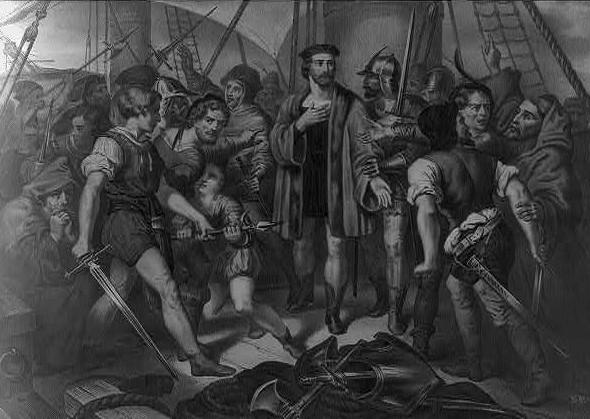
After six weeks in Spain, Columbus, freed of any wrong doing, was released by the Sovereigns and given commission for another voyage. Ordering Bobadilla to collect what was due to Columbus, by trade and mining of gold and to give these into the custody of Columbus’s designated agent. On March 14, 1502, with orders forbidding Columbus to stop at Hispaniola, Columbus embarked with four caravels and arrived later off of Hispaniola on June 29, 1502.
In accordance with the orders of the sovereigns, the first intention of Columbus was to steer directly to the land of Paria, and follow the coast till he came to the Strait, which he felt sure must be further on towards the west. But he was obliged to change his plan, because his largest vessel, not having the masts sunk deep enough in the keel, could not support the sails when spread, and the other vessels were delayed to keep her company. He, therefore, decided to touch at San Domingo to exchange this vessel for one of those which Nicolas de Ovando had lately brought out, or else to purchase another. This seemed to him so reasonable as to be safe from suspicion or blame. Ovando had arrived at San Domingo on the 15th of April. On the arrival of the new governor, all Bobadilla’s importance vanished.
Solitary and neglected, deserted by the very persons he had favored the most, he experienced in his own case the fickleness of the popularity gained by flattering the vices of the multitude. But a strict investigation was made of Roldan and his companions, and most of them were ordered to Spain to answer for what they had done. None of them seemed uneasy about his fate, relying on the influence of their friends to protect them at court, and on Fonseca, who they knew was ready to defend any one who had shown himself hostile to the admiral. They also knew that the great quantities of gold they had collected would remove any danger that threatened.
All these [wealth] were to be sent back to Spain in the ships that brought Ovando to Hispaniola. Bobadilla took passage on the largest of the vessels, with an immense quantity of gold, the proceeds of the Crown revenues under his administration, which he confidently expected would cover every fault that might be found with his conduct. Roldan and his principal confederates were embarked on the same ship, so that with the gold intended for the Crown, and that which Bobadilla, Roldan, and the other chiefs of the revolt put on board as their private property, there was on the flag-ship the largest amount of gold that had ever been got together. But the greatest marvel was an enormous piece of virgin gold, famous in the old Spanish chronicles, and the largest that had yet been found.
By order of Bobadilla, Alonzo Sanchez de Carvajal, was in charge of the flimsy and smallest ship, Aguja, taking with him 4,000 pieces of gold that he had collected, belonging to Christopher Columbus— partly revenues collected since Columbus’s arrival, and partly what Bobadilla had been compelled to restore. It was the hope that Columbus’ gold on board the Aguja, would sink on it’s trip back to Spain.
The preparations were all made, and the fleet ready to sail, when, on the 29th of June, the little squadron of Columbus appeared off San Domingo. Columbus sent Pedro di Tereros, captain of one of the caravels, on shore, to inform Ovando of the need he had of changing one of his vessels, and to ask, at the same time, for permission to come into the harbor for shelter from a violent hurricane which Columbus saw, from various signs, would soon be upon them. Ovando refused both requests.
Columbus was deeply hurt at his repulse. “Who,” he wrote soon after to their Majesties, “who, not even excepting Job, would not have died of despair to see, when my safety and that of my son, my brother, and my other friends, was at stake, under these circumstances, access forbidden me to that land, and shelter in that port, which by the will of God and at the price of my blood I had won for Spain?”
But, in spite of his indignation, Columbus was anxious about the certain danger to which he saw the fleet, about to sail, would be exposed. He, therefore, sent Tereros back to entreat the governor not to let the fleet weigh anchor, assuring him that he saw sure indications of the approach of a frightful hurricane, and woe to the ships that should be caught at that moment at sea, and exposed to the fury of the winds and the rage of the Ocean.
But they saw no signs of any danger, and seamen and pilots were impatient to start. Columbus’s predictions were scoffed at, and he was ridiculed as a false prophet.
Columbus, finding that his attempts to save those imprudent men were idle, and certain, from his long experience in observing the natural phenomena of those regions, that the hurricane was imminent, and would come from the land side, kept as close as possible to the shore, seeking for some bay or deserted river to shelter his little squadron. His men were discouraged and astounded at finding themselves excluded from a port of their own country, where even strangers, under like circumstances, would not be refused hospitality and shelter. They complained of their misfortune in sailing with a captain who seemed excluded from common justice, and anticipated nothing but evil on a voyage on which the sea persecuted them with constant dangers, and the land refused them protection or shelter.
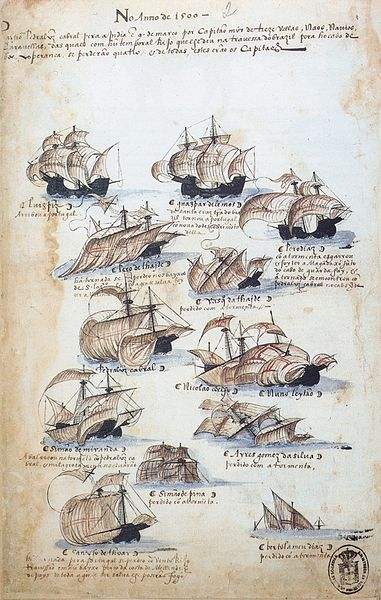
Twelve of 13 ships that were part of Cabral’s fleet are depicted. Many were lost, as can be seen in this drawing from Memória das Armadas, c.1568
In the mean time, Bobadilla’s beautiful fleet of twenty-eight sail, with songs and music, left the safe harbor and sailed boldly out on the open sea. Sailing from Ozama and made for the Mona Passage, which is the Strait between Hispaniola and Puerto Rico that connects the Caribbean to the Atlantic. Columbus wrote, “The storm was terrible and on that night the ships were parted from me. Each one lost.” Columbus had instructed his convoy that if they should become separated, they should meet in the harbor on Ocoa Bay after the storm. His entire fleet arrived safely in Ocoa Bay on Sunday, July 3rd .
As they reached the eastern extremity of Hispaniola, the signs that precede a storm were manifest to every one, but the open menace was so quickly followed by the act, that the fleet had no time to seek shelter from the wrath of the sea, or to reach the open ocean and avoid the rocks near the shore. The tempest that burst on them was one of those tremendous hurricanes that sometimes gather up in tropical latitudes. The hurricane caught the convoy in the Mona Passage head on. The flag-ship, on which were Bobadilla, Roldan, and the rest of Columbus’s most bitter enemies, was one of the first to feel the eye of the hurricane, and, driven on a rock, went down with all on board. The others, after a more or less desperate struggle for life, were broken or sunk. Three got back to San Domingo in a pitiable condition. In all, five hundred mariners perished.
Whilst Bobadilla’s fleet met with a fate unparalleled in history, smallest of all the fleet, the Aguja, carrying Columbus’s gold, came through unharmed and she crossed the Ocean, blessing God, arriving in Spain without the loss of a man or a thing.
Francesco Tarducci, The Life of Christopher Columbus, (Detroit: H. F. Brownson, Publisher, 1890), Vol. 2, pp. 227, 229, 230-232.
Short Stories on Honor, Chivalry, and the World of Nobility—no. 573
